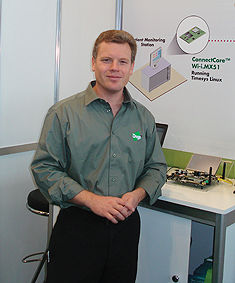
As part of our “Electronica 2010” series, we had the opportunity to talk with John Schwartz, Technology Strategist with Digi International, a major player in the market for wireless semiconductor components. In the interview to follow John provides a short overview of the company history, current and future strategic thrust, as well as the focus points for the years to come.
DIGI products are pretty much known to our readers; please tell us something about the company and it history
Digi International® was founded in 1985 as DigiBoard. The company went public as Digi International in 1989 and is traded on the NASDAQ National Market under the symbol DGII. Digi® employs more than 600 people worldwide. With our global headquarters in Minnetonka, Minnesota, and regional sales offices throughout North America, Europe and Asia, our products are available through approximately 262 distributors in more than 70 countries. We also have engineering locations in North America, Europe and India.
In this company development phase, what is your strategic creed, what is your primary focus, the secondary focus
When we started in 1985, we primary made products that worked with and expanded the serial port on computers. Digi boards were used in lots of applications, but industrial monitoring and control was one of the areas where they saw a lot of success. As we’ve continued to expand our product lines, we’ve grown from serial to USB, from USB to Ethernet, and from Ethernet to wireless. Our primary focus is to be able to provide the industrial and M2M world with all of their communication needs. More and more that means providing them with wireless solutions – our primary focus. Additionally we want them to be able to manage all of these devices remotely from multiple platforms. Our iDigi cloud service is designed for that very purpose.
Tell us few words about the technology and product strategies
Regardless of which Digi product you are talking about, because of the environments that these product are going into we have several design goals when it comes to our products. One is for the products to last a long time in difficult environments, and the other is for the products to be easy to use. In many respects these two goals go hand in hand. If the product is easy to use, then often there are not as many ways for the products to go offline or quit working. Also, one of our goals is to make every product be capable of remote management. That way, if issues do arise they can be taken care of remotely.
… what about the market strategy
There are a number of different markets that our products work well in, but some of the latest markets to adopt some of our products include the transportation, medical and smart energy markets.
In transportation, it is becoming increasingly common to monitor either the cargo itself or certain things about the transportation (truck, ship, plane) that is carrying the cargo. Medical is a growing area and smart energy communication is penetrating everything from the generation side (windmills, solar panels, etc,) to the devices that can help us control our usage in the home such as smart thermostats and load control devices.
What’s the position of E-Europe in your strategy and what are your expectations form this area
Traditionally EE has been a smaller market, but it has some positive things going for it. The population is highly educated and with the open markets that are now in place in EE, we expect that this will be a growing area. In order for growth to proceed the way we want it to, it will require a lot of local support in the way of distribution and companies that will design systems that are tailored for the specific regions and meet local government requirements.
We are excited to see what EE will become in the next five to ten years.


